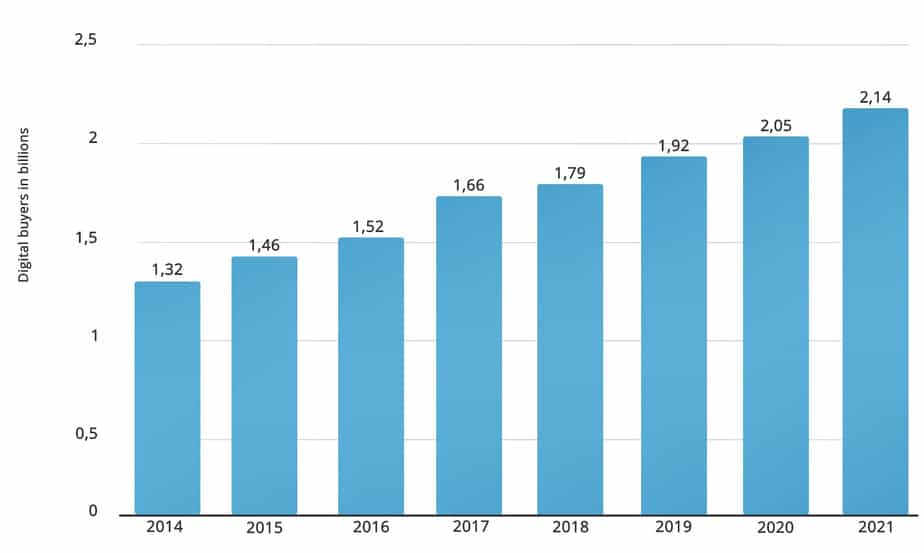Today we can buy and sell any product or service online. The latest solutions and the COVID-19 make the pattern new normality that will keep gaining pace in the future. According to the forecast, over 2.14 billion people worldwide will buy goods and services online in 2021. That’s the very reason to start an online business or online sales channel. If you don’t know how to get started, then this article is a must-read to the end.

6 Steps to Launching an Online Business
We created a quick but comprehensive guide that breaks down the process of launching an online business into manageable cases. After reading the post, you’ll know how to get started. So, let’s overview 6 steps for starting a successful online business.
Step 1: Decide on a business idea and find your niche
In case you just want to expand your physical business, then you already have the idea and service or product to offer online. Yet, when you’re a starter, then you need to decide on a business idea first.
The best way is to find a need and fill it. Don’t start with the product but start with a market. Nobody wants to launch a new business in a market that’s already flooded with competing brands and/or denominated by a leading company. However, the niche is to be viable as well.
Carry out keyword research to find what people try to solve and there are not a ton of competitors. Also, you can visit forums and/or conduct research among your friends, relatives to find out if there is a service/product/content they need but failed to find on the internet or there is too little info available. Having a business idea, you need to validate it.
To do all that, you need to do market research. So, before you invest in your idea, carry out the following techniques:
1. Check customers’ reviews.
If you want to gauge current customer interest, then just look through the competitive reviews and learn what the real customers respond to. Thus, you’ll get insights on what they like/dislike, understand their needs and improvements to implement to meet the expectations, check the overall volume of feedback, and just get an idea of the active market size.
2. Create a landing page.
Launching an online business or thinking about it, you need to understand if your product is USP or not. So, before you launch the site, you can create and set up a landing page or use social media. Today there are a lot of tools like Crello — a free business card maker — that can be used for creating a thriving landing page or posts about your product that give a quick rundown of:
- Overview of the goods/service;
- Features;
- Options, etc.
It can also include the subscription form so that you can start building out a mailing list to learn and target your potential buyers after launching your site.
3. Carry out a competitor analysis.
Define your main competitors in the niche and just conduct the research of them. Just check how they work, what they are doing to fill a need, who their customers are, what they do well, and what needs to be improved, and so on. It’s a way to understand who your potential users are, learn about the product from a market that already exists, and just do better than the competitors.
4. Define your target audience and create a customer persona.
It’s crucial to understand who your potential users and buyers are. Only if you know who you need to target, you can make the right decisions about the way your website works, looks, and feels, saying nothing about pricing, options, features, etc. provided.
5. Survey potential customers and seek feedback on your idea.
It’s very important to hear what potential customers think about your idea and future product/service. You can do that by asking people you know, run focus groups, create online questionnaires. In case you create a landing page with a subscription form, you can survey the people who already demonstrated a level of interest to receive actual feedback.
Step 3: Select a business model
In case you’ve got a physical business that you want to expand online, then you can just move to the next point. Yet, if you want to start a new online business, then you need to choose a business model that will depend on the products and market.
So, when dealing with an online business, you can select out of 4 common models:
- Affiliate marketing site. You create appealing content around the products offered by other retailers for drawing traffic to their online shops for a finder’s fee.
- Run a drop-shipping business.
- Resell inventory that you buy and hold by yourself.
- Co-work with another company that produces and ships your products without a need to handle a physical handle inventory.

Step 4: Design and build your website
When you have an idea (product/service), business plan, and a brand name, then it’s time to launch your site to sell your products/services online. You can build a site by yourself using tools or go to the agency so that the professionals develop the good-looking and well-working site with all the needed features. Choose the variant that suits your budget. Yet, in case you choose the first variant, then keep in mind that it should be user-friendly, adaptive, contain all the needed features and options (filters, search, categories, cart, checkout, blog, etc.)
After you build the site, you need to fill it with the content. And there is no matter whether the site is to provide the information about the product, your offline business, sell goods/services, or do something else, there are some rules for a written copy to keep in mind:
- It must be well-written without any errors;
- It should inspire interest in the product and clearly explain what you’re doing or selling here;
- It should provide relevant info to answer what the user has come to the website/particular page to find out;
- Don’t forget to fully prime it for SEO.

Don’t set it and forget it: measure your online success. That’s why you need to set up Google Analytics or any other tools to collect the data and monitor how well your website is performing when launching the business. Besides, such tools can help you to test any changes and their impact on the baseline data like conversion rate, bounce rate, etc.
Step 5: Make it legal — register your business
Mind the legal aspect of your business even if it’s online one. So, you need to learn online business regulations and register your business according to them. Here are a few steps to take:
- Choose an official business name and fill out the appropriate paperwork to make it official. In such a way you can gain insights about your business plan, taking into account such aspects as charges, shipping and production costs, web hosting fees, etc. Also, you can get sure to comply when you get things up and running.
- Register a domain name.
Make it simple, short, and eye-catching. It will be perfect if it’s related to your product/service name. Go to the domain registration company to test the variants available and choose the best one for you.
- Learn about tax obligations.
You need to be aware of the sales tax requirements as well as online sales tax obligations. It’s crucial to properly configure a shopping cart so that it automatically collects the right amount of charges.
Step 6: Start marketing your eCommerce business
Having reached the step, it’s more likely that you’ve got a product and website, so it’s time to think over the marketing plan and strategy. You need to promote your business to attract buyers and build a brand. You should work-out the marketing campaigns based on:
- Your unique line and service/product (your USP);
- Your target audience and their needs, wishes, pains (you need to provide the best solution for their problems with which they come to you);
- The data gathered about your visitors to the site.
So, to build an effective marketing strategy and plan you need to learn your audience continuously. Only in such a way you can implement the changes to retain customers and attract new buyers. Fortunately, today you’re free to choose out of a host of online marketing options to build a marketing plan that fits your budget. However, no matter what option you’ll employ exactly, it’s highly important to tailor your marketing to your customer persona for solving its problems, tasks, pains, wishes, needs.
Final Words:
With this guide and a strong business plan in mind, you can build a brand that will be successful and profitable. So, homing in on the following elements, you can avoid the common mistakes and pitfalls, and create an online business that can be scaled and expanded:
- Find your niche and think about the potential users and real clients to develop a clear brand that speaks and appeals to your target audience.
- Perform market research in your niche to be better informed to price your services/products for avoiding shortchanging your business.
- Choose a proper business model and select the right eCommerce platform to gain a better understanding of the business’s operations and marketing strategy.
- Build a marketing plan to reach out to consumers and potential buyers to grow the business.
Keep in mind that you might constantly improve/change the service to meet the customer demands and expectations, stay competitive, evolve.


















Leave a Reply